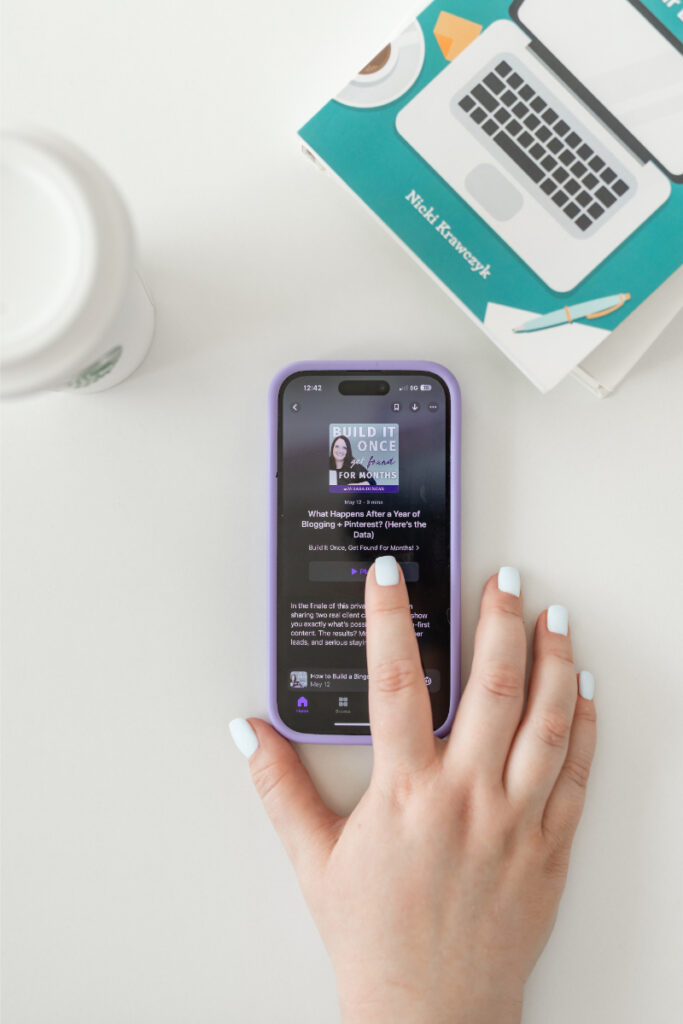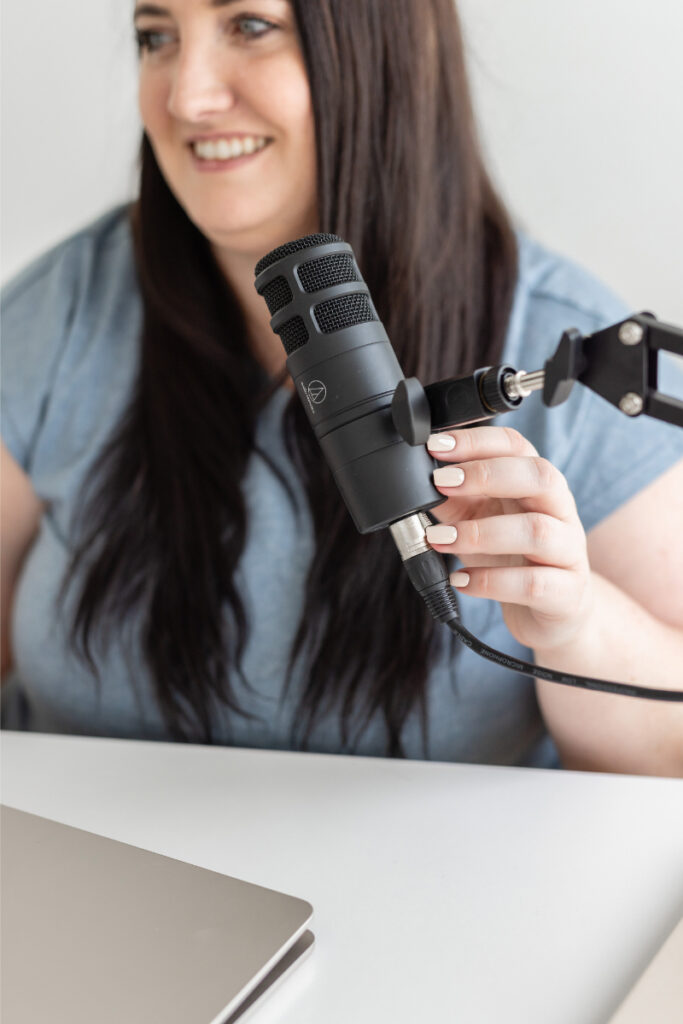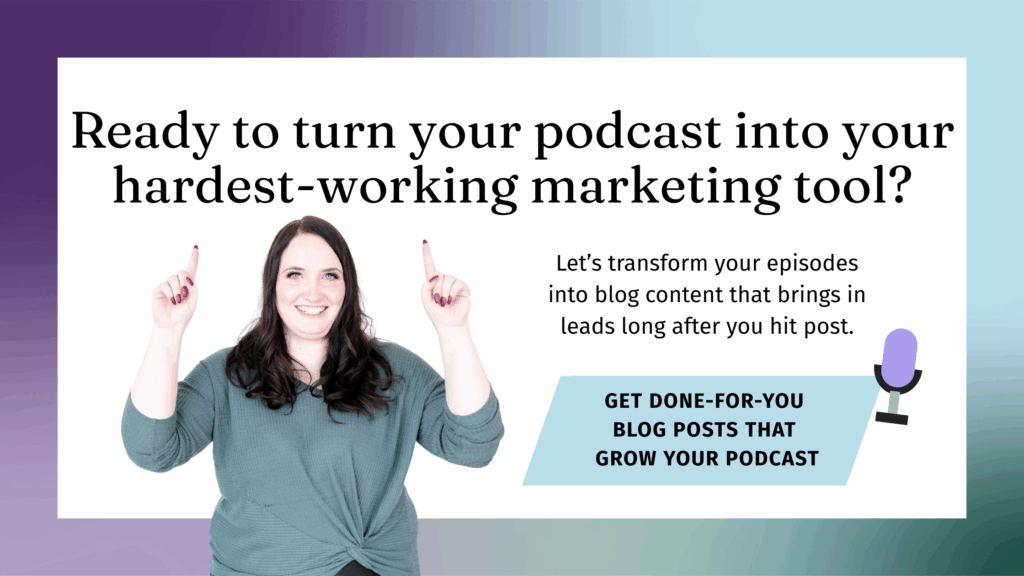You’re already pouring time and energy into creating podcast episodes, but is it guiding listeners to your offers? With the right strategy, your show can become a lead-generating funnel that builds trust with your audience and gently guides them toward your offers.
I’m Kara, content strategist and founder of The Kara Report! I help creatives and service providers turn their long-form content—especially podcasts—into evergreen marketing systems. If you’ve been stuck in the social media hamster wheel, my goal is to help you build a visibility strategy that works while you’re offline to still bring in dreamy clients.
In this post, I’ll show you how to design a podcast strategy that doesn’t just get downloads, but also becomes a lead-generating funnel for your business. From structuring your episodes intentionally to building a bingeable Pinterest and blog presence, this is about helping you repurpose content in a way that actually moves the needle.

Start With the End in Mind: What are You Selling?
Before you hit record, you need to be crystal clear on what you want your podcast to lead to. A lead-generating funnel starts with intentionality. Specifically, being intentional about what you’re ultimately inviting listeners to buy. Whether it’s a service, digital product, course, or template shop, your podcast should warm your audience up to that offer.
This doesn’t mean every episode turns into a sales pitch. But it does mean each episode should serve a purpose.
These are the kinds of strategic questions to ask as you plan your content:
- Are you answering a question your audience has before they buy?
- Are you shifting a belief that might hold someone back from saying yes?
- Are you sharing a case study that builds trust?
When you keep your offers in mind from the very beginning, it becomes easier to reverse-engineer episode topics, stories, and calls-to-action that align with your larger marketing goals. This is how your podcast moves from being “just content” to being an actual asset in your sales process.
If you’re not quite sure what your funnel should point to, start by reviewing your most profitable or scalable offer, and build backwards from there.
Use Intentional Episode Structure that Builds Trust and Drives Action
A strong episode structure keeps your audience engaged and moves them closer to working with you.
Here’s a simple format that helps you build trust while strategically guiding listeners to the next step:
- Open with a hook
Start with a compelling question, stat, or story to grab attention right away. This encourages listeners to keep tuning in beyond the first 30 seconds. - Establish credibility early
Remind your audience why you’re the person to listen to. For example, you could share a quick anecdote, stat, or result that builds trust from the start. - Preview what’s coming
Outline what the episode will cover so your listeners know what value they’ll get by the end. - Deliver clear, valuable takeaways
Focus on transformation, not just delivering information. Teach or explain in a way that helps your listener picture how they can implement what you’re saying. - Naturally introduce your offer or next step
Instead of pushing a product, position your offer as a logical next step. Phrases like “If this is something you want help with…” can be softer but still effective. - Close with a CTA that fits your funnel
Invite listeners to download a freebie, visit your site, book a call, or listen to another episode, whatever keeps them moving through your funnel.
When your podcast episodes are structured with intention, your content becomes more than just a conversation, it becomes a strategic part of your sales process. But even the most well-structured episodes need somewhere to send your listeners next. That’s where a thoughtful lead magnet comes in.

Create a Dedicated Opt-In or Lead Magnet for Listeners
If you want your show to become a true lead-generating funnel, you need a strategy that guides listeners from aha moments to action. That’s where a dedicated opt-in or lead magnet comes in. When your freebie speaks directly to your audience’s needs and aligns with your offers, it turns casual listeners into subscribers and eventually, clients.
Create a Dedicated Opt-In or Lead Magnet for Listeners
If your podcast is getting downloads but not driving leads, the missing link might be your opt-in strategy. A strong lead-generating funnel always includes an intentional, value-packed offer that moves listeners deeper into your world. Below are a few ways to make that happen.
Make the Next Step Obvious
After you’ve built trust through the episode, tell listeners exactly what to do next. Whether that’s downloading a checklist, signing up for a freebie, or promoting your services, don’t leave them guessing.
Align Your Lead Magnet With the Episode
Each lead magnet should feel like the natural “next step” after listening. If your episode is about website must-haves, offer a homepage checklist. If it’s about pricing, offer a calculator or mini training. Keep the momentum going.
Offer Something That Works While You’re Offline
One of the most powerful ways I’ve nurtured my own audience is through a 7-episode private podcast. It’s a behind-the-scenes look at the exact system I use to help clients stop relying on social media and build a visibility flywheel that drives leads while they sleep. This is the kind of lead magnet that keeps working long after you hit publish.
Focus on Lead Quality Over Quantity
Don’t just create freebies for the sake of it. Make sure each opt-in is designed to attract people who are ready to take the next step with you. Need more ideas? I share strategies for attracting the right people in this blog post.
The right opt-in turns passive listeners into warm leads, and helps you nurture them through your lead-generating funnel without extra effort on your part. Whether it’s a quick win or a deeper experience like a private podcast, the goal is to move listeners into your world in a meaningful way. Once that’s in place, you’re ready to amplify your reach and bring even more qualified leads into your lead-generating funnel. Let’s talk about how to do just that, starting with Pinterest and SEO.

Send Traffic to Your Podcast Through Podcast and Blog SEO
Even the best podcast episode won’t grow your business if no one hears it. And while social media posts disappear fast, Pinterest and Google can send people to your podcast long after it airs. That’s the beauty of search-based marketing. When it’s done well, it builds momentum over time. To turn your show into a lead-generating funnel, you need to make it discoverable first.
Here’s how to get more visibility using content you already have:
- Turn each podcast episode into a blog post.
Not only does this help with SEO, but it gives your content a second life. A blog post can include keywords, links to your lead magnets, and visual elements for better user experience. - Design pinnable graphics for each episode.
These can live in your blog posts and be pinned directly to Pinterest. Make sure each pin links back to the full blog post or podcast episode page. - Use keywords your audience is already searching for.
Pinterest and Google both rely on keywords, so make sure your titles, descriptions, and alt text reflect how your audience talks about their pain points or goals. - Repin and reshare consistently.
Pinterest thrives on repetition. Scheduling fresh pins (even of the same content) helps you stay visible without constant reinvention. - Make your show bingeable.
Use blog categories or Pinterest boards to group related topics so new visitors get lost in your content, in the best way possible!
Want to see how this strategy plays out in real life? Check out this post on growing your podcast with Pinterest and blog content to learn how to turn single episodes into evergreen traffic sources.
Your content deserves more than 24 hours of fame. With a little SEO and Pinterest strategy, your podcast can keep pulling in the right people on autopilot.
Nurture New Leads with a Welcome Sequence that Continues the Podcast Vibe
Getting someone to subscribe to your list is a win, but it’s just the beginning. To turn that new listener or reader into a true lead, your welcome sequence should feel like a seamless extension of your lead-generating funnel, keeping the conversation going and moving them closer to working with you.
Think of it as the natural next step in your lead-generating funnel. If they liked your podcast, this is where they get hooked on your brand.
Here’s how to keep that energy going:
- Start with a warm, personal welcome.
Introduce yourself, share your mission, and let them know what kind of value they’ll get from being on your list. - Recap your most popular or foundational podcast episodes.
These help new subscribers catch up and give them a taste of your expertise. Frame them as must-listen episodes to binge next. - Invite them to connect with you on other platforms.
Link to your Instagram, Pinterest, and podcast homepage so they can follow you in the spaces they already love hanging out in. - Deliver a quick win.
Whether it’s a checklist, tip, or mindset shift, give them something actionable that builds trust and proves you understand their struggles. - Introduce your services or offers.
Keep it soft at first, but don’t shy away from planting the seed. Let them know how you can help and what working with you looks like. - Stay consistent in tone and energy.
If your podcast is casual and conversational, your emails should feel the same. This creates brand cohesion and deepens connection.
When done well, your welcome sequence doesn’t just inform, it converts. It bridges the gap between podcast listener and potential client, moving them deeper into your ecosystem with each email. That’s what a true lead-generating funnel does. It builds trust, delivers value, and gently guides people toward your offers.

Track what Converts: Not Just What Gets Downloads
It’s easy to get caught up in the number of downloads, listens, and likes. They feel like validation that your podcast is working. But those numbers don’t always reflect how your lead-generating funnel is performing behind the scenes. When it comes to building a true lead-generating funnel, those metrics don’t always tell the full story. Just because an episode is popular doesn’t mean it’s profitable.
Instead of chasing what performs well on the surface, focus on what’s actually moving people to action. Look at the episodes that lead to real results, like email sign-ups, inquiry form submissions, or booked discovery calls. These are often the episodes that align closely with your offers or tackle a specific question your ideal client is already asking. They might not be your flashiest episodes, but they’re doing the heavy lifting in your funnel.
Once you’ve identified what’s converting, use those insights to shape your future content. What themes come up again and again? Which offers are resonating? Which opt-ins are getting the most traction? Tracking this kind of data allows you to refine your podcast strategy over time and create a content ecosystem that supports your long-term goals.
Because here’s the truth, a podcast that performs well in the algorithm won’t necessarily perform well in your business. Prioritize the content that brings in the right people, and your podcast will become a reliable engine for growth.
Don’t Make Every Single Episode a Selling Episode
If every podcast episode feels like a pitch, listeners can start to tune out, or worse, unsubscribe. A strong lead-generating funnel doesn’t rely on non-stop sales messaging. Instead, it builds a relationship by mixing value with intention.
Your podcast should include episodes that:
- Offer value without expecting anything in return. Share useful tutorials, mindset shifts, or storytelling that resonates.
- Provide subtle breadcrumbs to your services. For example, sharing a success story that demonstrates the transformation you offer, without stopping to pitch at the end.
- Occasionally deliver gentle calls to action. A simple, “If this topic helps you, I’ve shared a free resource you can grab” can be effective without feeling pushy.
Think of your podcast like a conversation you’re having with a friend. You’d rarely go into a conversation planning a hard sell. Instead, you’d share, listen, and sometimes, naturally, bring up your work. That’s how a funnel works best: organically.

Creating a Monthly Marketing Plan Around Your Podcast
A solid monthly plan turns your podcast from just content into a true lead-generating funnel. Start by aligning episodes with your offers and goals. Whether it’s a launch, a waitlist push, or list-building season.
Then repurpose each episode intentionally:
- Turn it into a blog post with search-friendly keywords
- Share clips or takeaways on social
- Send it to your email list
- Create Pinterest graphics to drive traffic
- Pair it with a lead magnet or content upgrade
Use your content calendar to reinforce your lead-generating funnel by connecting each episode with a relevant offer, opt-in, or blog post. This approach builds a visibility flywheel, one that works for you across platforms.
Need help creating a system that actually works without burning you out? My private podcast walks you through the exact steps. It’s the same method I use for myself and clients to help them get found and get paid, without staying glued to Instagram. Listen to the series here!

Final Thoughts
Turning your podcast into a lead-generating funnel doesn’t mean overhauling everything, it just means being intentional with what you’re already creating. From structuring your episodes to planning your content calendar and connecting the dots between your podcast, blog, and offers, you can build a system that works while you’re offline.
If you’re ready to create content that actually converts, and want expert support to make it happen, my team and I can help you turn your podcast episodes into strategic, search-optimized blog posts that grow your audience and fill your funnel.
Building a strong lead-generating funnel is a long game, but with a sustainable strategy and content that works across platforms, you’ll attract aligned clients again and again. Want more content marketing tips like this? Don’t forget to follow along on Instagram, Pinterest, and Youtube for behind-the-scenes advice, strategy, and inspiration to grow your podcast with evergreen content.